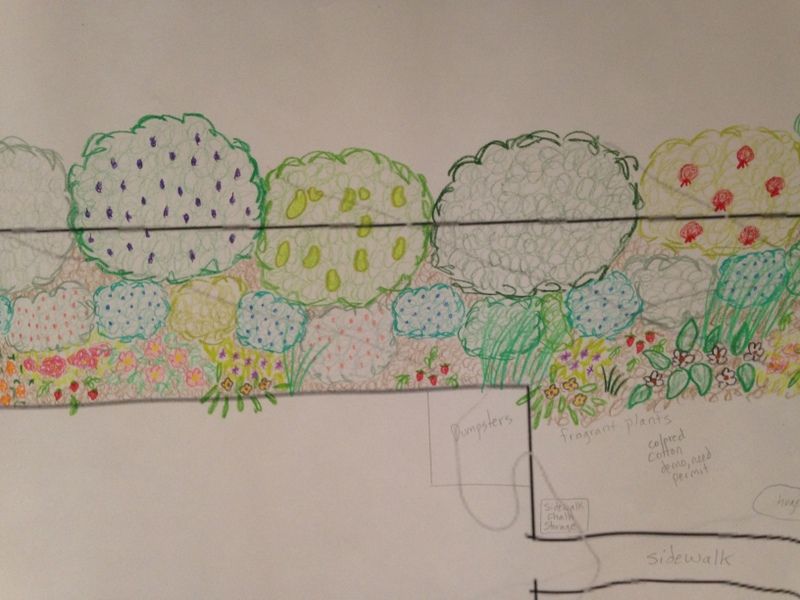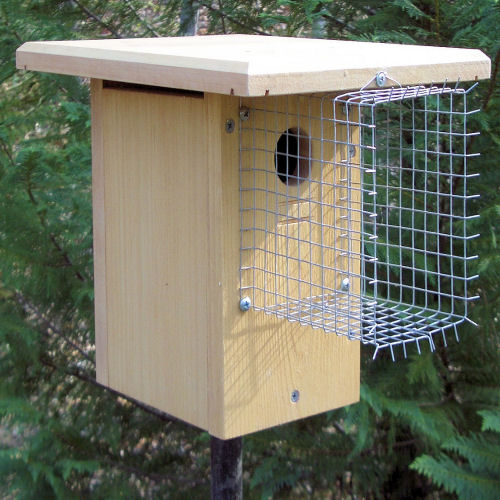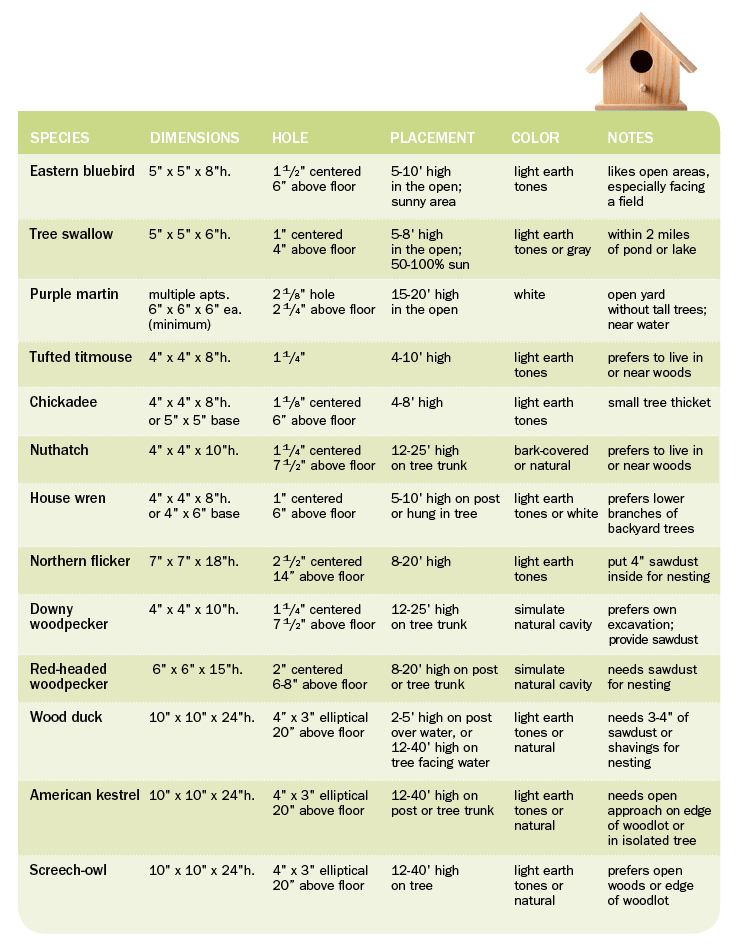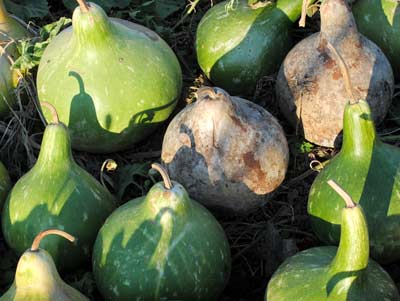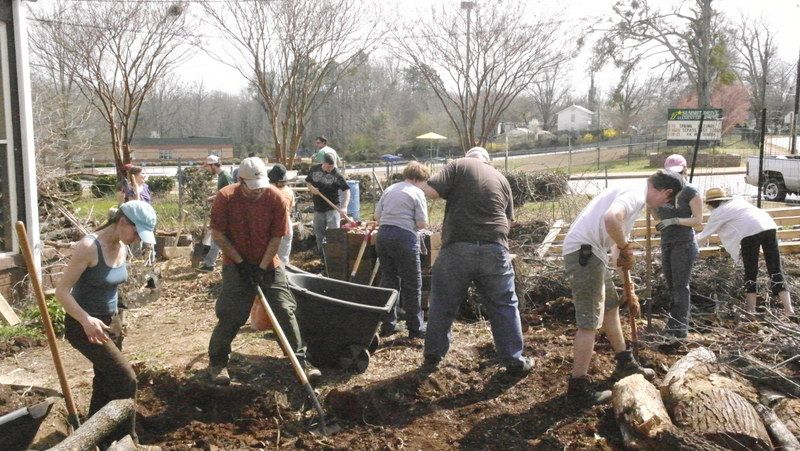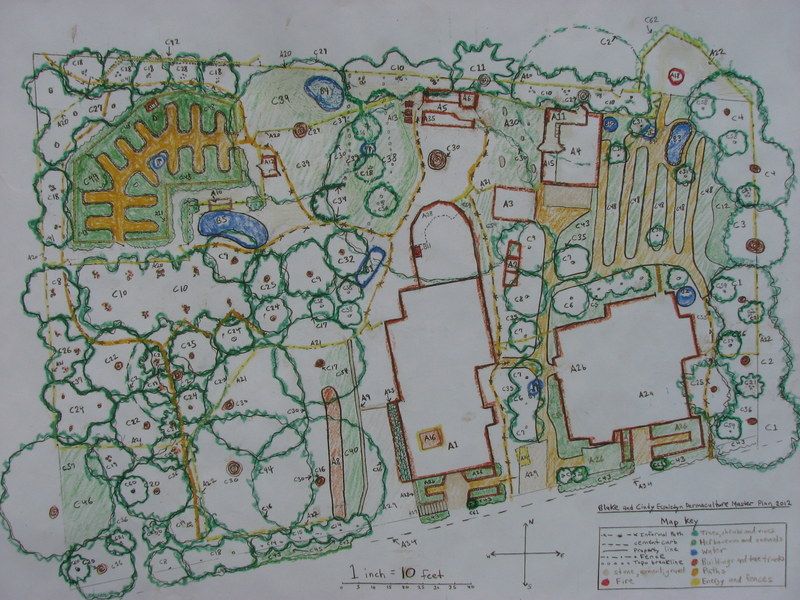Here's another update on YOUR garden, with tons of photos and permaculture tidbits:
YOUR Garden, 2/3/15
Monday, February 9, 2015
Tuesday, February 3, 2015
Birdwatching at the SC Upstate Demo Garden
I've been working out the details (in my head) of how to do birdhouses at the SCUPS garden for several weeks now and I think this is something members could really help me on. We could probably use reclaimed materials but I'd like to avoid recycling materials that haven't been proven safe for birds. I've seen some adorable birdhouse projects made from repurposed items, but they didn't look snake proof to me.
Here's our objectives:
This is how to make the guards (for a larger version click here), and this link has even more specific info on how to make the stovepipe baffle:
These are the hinged sides used to clean the birdhouse, which should have raccoon-proof latch on the bottom:
Here's some DIY bluebird house plans similar to the one in the above photo and here is another good description. Additionally, though most birdhouse recommendations say to put the house 5' off the ground, I've watched cats in my neighborhood jump that high and catch a bluebird parent out of the air as it tried to enter the house. Predator-proof sites say to use metal poles that are 8' - 10' high and sink 2' of that into the ground for stability.
Finally, here are the requirements for various species of birds. If anyone knows how to make these houses we can definitely use them:
Oh yeah, and we're DEFINITELY going to have purple martin bird houses, the site is just perfect for it -- especially after we add all our meadow wildflower plantings. It's possible I have one we can use (it is currently buried underneath my mom's Confederate jasmine vine, so I have to dig it out to see if it is in decent shape). The one I might have looks like this:
I bought some of Dr. David Bradshaw's improved birdhouse gourd seed strain to grow amongst our meadow plants. If they do well, we can add to the martin colony next year.
I know I said "finally" a while back, but we'll be adding bird feeders to the picnic area across from the garden. YAY BIRDS!
P.S. - Maybe not this year, but in the future how cool would it be to install a chimney swift tower and a rocket bat house?
Here's our objectives:
- Visible to kids at the school - fun!
- Made well, with long-lasting materials
- Able to be cleaned each season
- Discourages snakes (they kill nestlings in my yard every year, which is a natural process, but I'd rather not welcome the birds to a snake diner)
- Attracts native birds
- Discourages non-native house sparrows (click here to see why)
- Choose an area to make house wren nests to keep them happy (here's why, also check out this link that says house wrens deliberately add spider egg sacs to their nests because the spiders control the mites that attack their young -- awesome!!!)
- Discourages cats and other predators
- Make enough bird houses to put around the entire property, not just the garden. This includes the forest behind the flood catchment in the back of the school and the other boundaries. They need to be about 100 yards apart from each other.
This kind of guard discourages raccoons and cats:
This is how to make the guards (for a larger version click here), and this link has even more specific info on how to make the stovepipe baffle:
These are the hinged sides used to clean the birdhouse, which should have raccoon-proof latch on the bottom:
Here's some DIY bluebird house plans similar to the one in the above photo and here is another good description. Additionally, though most birdhouse recommendations say to put the house 5' off the ground, I've watched cats in my neighborhood jump that high and catch a bluebird parent out of the air as it tried to enter the house. Predator-proof sites say to use metal poles that are 8' - 10' high and sink 2' of that into the ground for stability.
Finally, here are the requirements for various species of birds. If anyone knows how to make these houses we can definitely use them:
Oh yeah, and we're DEFINITELY going to have purple martin bird houses, the site is just perfect for it -- especially after we add all our meadow wildflower plantings. It's possible I have one we can use (it is currently buried underneath my mom's Confederate jasmine vine, so I have to dig it out to see if it is in decent shape). The one I might have looks like this:
I bought some of Dr. David Bradshaw's improved birdhouse gourd seed strain to grow amongst our meadow plants. If they do well, we can add to the martin colony next year.
I know I said "finally" a while back, but we'll be adding bird feeders to the picnic area across from the garden. YAY BIRDS!
P.S. - Maybe not this year, but in the future how cool would it be to install a chimney swift tower and a rocket bat house?
Friday, January 23, 2015
The Founding of a Fedge (and other stories from Your Garden)
 |
| Before and after our work days Photos by Eliza Lord |
If you haven't heard the latest about the Upstate's first public, volunteer permaculture garden, get ready for the good news. Your Garden has begun. Like the recent warm, sunshiny break from winter (which made for a fantastic foray into the first plantings this past week end!), we hope this project will be a catalyst for useful permaculture plant growing and sharing. Photosynthesis everywhere, baby! Since our first work day last October, members of the South Carolina Upstate Permaculture Society have pulled ivy, cut down shrubs, dug stumps, built swale terraces, moved a monstrous mound of mulch and lovingly placed the first plants into the welcoming earth. And that is just the beginning.
 |
| Marking swales at Summit Drive Elementary. Photo by Nathaniel Lord |
 |
| diagram by Graham Burnett |
The goal for this garden is manifold in function! For SCUPS members, it will eventually provide plants and seeds, as we thin, divide and propagate on upcoming work days. For the school and community at large, it will be an educational walk, with signs added to identify plants and their functions in the ecosystem and within their guilds, as well as an opportunity for the school to incorporate permaculture related activities into their curricula.
 |
| Monarch Butterfly Photo by Eliza Lord |
And it goes without saying that the site will be a haven and habitat for many creatures besides humans.
In particular, we plan to plant lots of milkweed to aid the struggling monarch butterfly population. Birds, amphibians, lizards, snakes and other native pollinators are also most welcome.
October saw our first work day at the site, and it was a complete success. Members came from all over the Upstate and beyond to participate.
 |
| Shaping swale terraces Photo by Eliza Lord |
The major tasks we tackled included clearing a large area that was overgrown with shrubs and English ivy, and putting in some small earthworks to help the soil retain water on the steep slope.
 |
| Crushed hickory nuts Photo by Tina Huba |
Participants brought their own bagged lunches, but were regaled with tastes of local gourmet, not least of which were Eliza's mom Joan's homemade pomegranate jelly, made from the fruit from the family heirloom tree. We also had fresh, ripe fruit from the aforementioned tree, white currant tomatoes, pawpaw fruit, and maple syrup sweetened hickory nut milk from nuts patiently pounded by the teens in the group.
 |
| Young loquat Notice the green oats Photo by Eliza Lord |
Many thanks to everyone who planned, worked, donated plants or participated in this project in any way. We hope to plant and cultivate not only a garden food forest, but a culture rooted in ecological principles, earth care and people care, each living member mutually supporting, and being supported by, each of the others.
You can get involved!
We have regular work days planned, and if you cannot make it to any one of these, here is a list of plants you can donate.
Upcoming work days:
Location: 424 Summit Drive, Greenville
Tuesday, January 27, from 10am - 12pm
Every Tuesday after that from 10am - 12 pm unless otherwise announced
Saturday, February 21, from 10am - 1pm
Saturday, April 4 from 10am - 3pm
Sunday, May 10, from 10am - 3pm
Check our Facebook page for more SCUPS events and educational opportunities.
Not a member of SCUPS yet? Go here to join.
Friday, June 27, 2014
My Alternative to Roundup
 |
| little Weedinators |
I could have entitled this post, "This Simple Weed Control Method Will Blow Your Mind" Or, "The Best Organic Solution to Weeds You'll Ever See". (Because, you know, all content deserves to go viral).
But that would be untrue and misleading. It probably won't blow your mind, and it's not the best solution, either.
The fact is, however, that it is a solution that, combined with other strategies (like mulching!), is currently working well for me.
 |
| garden path behind the rabbit tractor |
Snowflake and Cupcake, it should be pointed out, are "not for eating". However, they do play an important role in our permaculture system as well as providing valuable fertilizer. They power my rabbit tractor, a triangular cage just wide enough to fit between the garden beds. Each day, the tractor is dragged a little way down the path so the rabbits can nibble down the growth and keep it manageable.
It's not a perfect solution. They don't eat all the weeds and there are places where it is hard to get around the cage to access their food and water. But it's adequate. And they provide other services, like eating piles of grass and other unwanted weeds and veggie scraps from the adjoining garden, or by being the soft, cuddly pets that don't complain and greet you happily each day.
 |
| The pre-tractored path. Pay no attention to the weed ridden bed of spent greens on the left |
As with anything we seek to accomplish, there are no fantastical solutions. There's another sort of "magic" to be found, however, within ordinary processes; the tested, tried and true. Our ability to observe the habits and interactions of plants and animals in nature allows us to creatively put them to use in ways that benefit the whole system, as well as provide us with a yield.
This power to observe, learn and create is one of our greatest assets as humans. We can reflect and make adjustments to maximize symbiotic relationships in our landscapes and lives. It is an ongoing process. A process that, it may be noted, begins with wonder....
Wednesday, May 28, 2014
11 Principles for Design
 |
| alder seedling |
I ended up designing one that illustrated all of them. That's not really anything extraordinary, because permaculture is such an integrated system, it's almost impossible not to follow them once you are started down that road. Toby Hemenway writes in Gaia's Garden, that permaculture "...principles have deep and surprising interconnections..."
Now for an overview of the project. The spring before last, I had mob grazed a couple pigs through the pasture, part of which bordered the garden. There is a particularly low, poorly drained spot on the southwest corner of the garden, and here they had rooted up the ground so badly that it was both full of puddles and a tripping hazard. And strangely enough, the ruts they made were partially on contour. So I took a rake and made some berms and swales to finish what they had started. I ended up with something akin to the growing system used by the Aztecs called chinampas, only in miniature. During the fall, winter and most of the spring, the swales stayed full of water and hosted a variety of insects and amphibians. I grew sweet potatoes and tomatoes in the berms last summer, and while they did ok, it definitely needed improving.
As in the chinampa system, to start the project off this spring, I waited until the swales had dried up, then shoveled the muck from the bottom onto the berms. After this, I decided to follow Bill Mollison's instant garden technique on page 103 of Introduction to Permaculture, which is similar to a lasagna garden. First, any weeds were slashed. Then seedlings were planted. I put elderberry, sunchokes and sweet potato tubers left over from last year's crop in two of the berms in the back, and ground cherries, dwarf sunflowers and Mayo Indian amaranth in two on the front. This was arranged to take advantage of the noon to sunset exposure without the taller plants shading the shorter ones. Straw and aged chicken manure were strewn near the seedlings, then a weed barrier of paper and cardboard was added. On top of this was placed a thick mulch of leaves, followed by a more aesthetic layer of pine straw. Along the garden fence I planted a cross vine, wild rose and an alder. Most of these plants came from the moist woods and creek bank across from the pasture, and I chose them because I knew they would tolerate the wet soil conditions of the cold weather season in their new home.
 |
| berm planted and mulched |
On to the principles. The first principle is Relative Location. This means that each element in a permaculture design is placed beside other elements to maximize the positive interactions between them. Permaculture is primarily a design science of relationships. In my case, the swales were placed to collect the nutrient rich runoff from the chicken run inside the garden. And placing this in context, the chicken pen is downslope of an oak grove that surrounds the septic system from the house. So nutrients taken up by the oaks are shed in their leaves, which are then raked and thrown over the fence as mulch for the chickens to scratch in. These break down or are converted to worm castings, some of which are eventually washed through the mini chinampa garden along with chicken manure, which causes algae to grow in the swales. This feeds the vernal pond critters and breaks down into a rich muck by the time the warm weather arrives, which can be scooped onto the berms to fertilize the plants there.
Each Element Provides Many Functions, and it's twin, Each Function is Supported by Many Elements comprise the second and third principles. The functions of the chosen plants include food for humans and chickens, fertility (the sunchokes and alder and elderberry provide organic matter for the soil when they are pruned or cut down for regrowth the following season, and alders fix some nitrogen), hedge for the enclosed garden, and nectar for pollinators. The shaped landscape also manages fertile water, allowing it to seep into the swales, while the berms provide elevated growing space during the wetter seasons so roots are not drowned. The sheet mulch functions to suppress weeds and to hold moisture in the soil. And the list could go on.
 |
| elderberry seedling |
Use of Biological Resources: Most materials were gotten onsite, as was mentioned, from the surrounding ecosystem. The yields of the ecosystem, it is hoped, will increase further when brought into a system that is designed to increase the number of positive interactions. For instance, elderberry will probably yield more berries when brought out of the shade and placed where it will receive nitrogen and phosphorus from the chickens.
Energy Cycling: As was previously illustrated manure feeds the vernal pond habitats in the swales, which feed the surrounding plants, some of which are used the feed the chickens (sunflower, amaranth, rose hips, sunchokes, sweet potato greens, extra elderberries) who utilize it and convert it to manure, and the cycle continues. But there is also a yield beyond this cycle in the food provided for humans (elderberries, ground cherries sunflower seeds, amaranth and sweet potato greens, sweet potato slips for the garden, sunchokes, rose hips) and pollinators (roses, sunchokes, cross vine).
 |
| sweet potato sprout |
Small Scale Intensive Systems: While it is a lot of work to install initially, maintaining the mature system should be relatively easy with harvest and chop and drop mulching the primary chores. The scale of this project is small enough for a woman and her hand tools to accomplish and it was plugged into already existing nutrient cycles that had been set up before. So small systems can be built a little at a time, and as these need less and less maintenance, other small systems can be plugged into their outputs. Since many of the plants in this system are easy to grow perennials or self seeding annuals, this can be considered a zone 2 area, needing fewer visits than the kitchen garden or chickens in zone 1. (Zone planning involves placing elements at consecutive distances from the house according to the rate of visits needed by the human residents.)
Accelerating Succession and Evolution: With pigs and people shaping the land to capture and hold water and nutrients, the soil quality can be improved much faster which amounts to more species and individuals benefiting from higher yields.
Diversity: A variety of plants and habitats supports a variety of creatures. When humans direct their energies to supporting the whole ecosystem, rather than forcing a single yield for themselves, their needs are met and the continuing ability of the system to provide for all of its inhabitants is assured.
 |
| ground cherry seedling |
Edge Effects: More diversity is found at the edge of two different ecosystems, such as a grassland and forest, than away from it. In this system we have a small orchard where chickens run meeting swale ponds and berm beds, meeting pasture. Patterns that increase edge are ideal, and in this case the shape of the land was altered vertically to create more growing space (berms vs. flat ground) and more edge between air and water and soil.
Attitude: At first, the muddy, boggy mess left by the pigs presented a problem. But instead of trying to solve a problem by reversing the effect, a little creativity and extra energy turned it into a solution for something else: a self irrigating growing area and runoff management system.
We never did get around to the project I designed at our last permaculture meeting, we were having too much fun. But that's not a problem, it's just an opportunity for a blog post (and for me to get some good exercise).
Mollison concluded the list of principles by stressing that information and imagination are the only limits to the number of uses and relationships possible in a permaculture system.
Thursday, March 27, 2014
How to Do a Free SCUPS Group PDC
A while back, members of SCUPS decided to do their own PDC classes. These don't involve getting certification at the end (most certification courses run around $1,000 per person), but they do involve absorbing the knowledge of a PDC designer for free. The more PDC designers our group has, the more permaculture can spread in the upstate.
We started out recommending the free PDC videos at the Regenerative Leadership Institute. Most of the members who watched these videos didn't like how unstructured they were and their poor audio. Larry Korn seems like a fascinating guy to have a conversation with, but not the most intuitive instructor. Additionally, in the last month many respected permaculture organizations have come out against the founder of RLI (not Larry Korn) due to complaints of scams and poor personal relations with customers. Fortunately, we've discovered that Will Hooker from NC State has put up even more of his class lectures and they are of excellent, high tech quality with locally relevant info. We're now recommending them instead of the RLI materials.
Though it is possible to do the materials on your own, we suggest SCUPS members ask around to form groups of 2-4 families who then learn the materials as a group. We also recommend that you give your SCUPS PDC group a name because then we can discuss each group's activities on the Facebook page without getting confused about who is doing what. (the name "SUPA BOB" is already taken by our group so even though you probably wanted your group to be called "SUPA BOB," you have to pick something else -- sorry). :)
You can set up your group any way that suits you, but here's a suggested curriculum that is working for SUPA BOB:
SCUPS FREE PDC CURRICULUM:
Materials
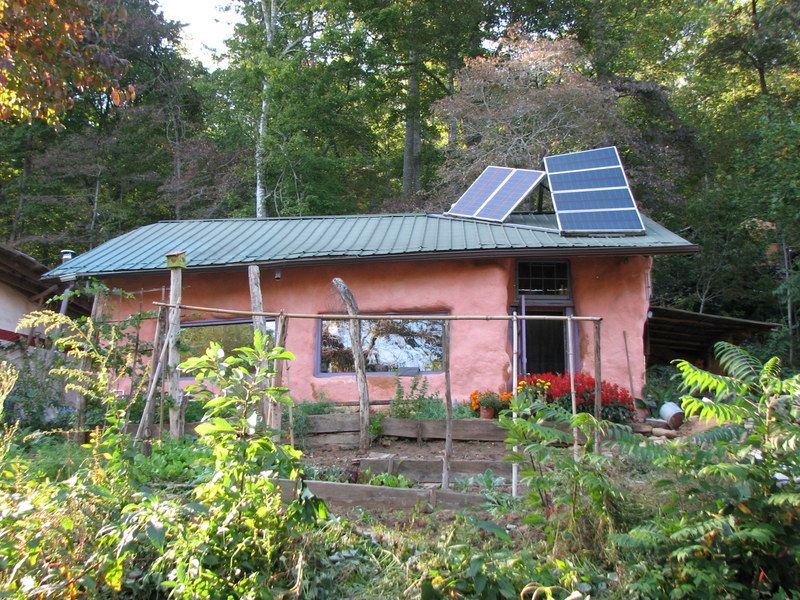 |
| Photo Caption: One of the houses at Earthhaven Ecovillage in Asheville, NC |
We started out recommending the free PDC videos at the Regenerative Leadership Institute. Most of the members who watched these videos didn't like how unstructured they were and their poor audio. Larry Korn seems like a fascinating guy to have a conversation with, but not the most intuitive instructor. Additionally, in the last month many respected permaculture organizations have come out against the founder of RLI (not Larry Korn) due to complaints of scams and poor personal relations with customers. Fortunately, we've discovered that Will Hooker from NC State has put up even more of his class lectures and they are of excellent, high tech quality with locally relevant info. We're now recommending them instead of the RLI materials.
Though it is possible to do the materials on your own, we suggest SCUPS members ask around to form groups of 2-4 families who then learn the materials as a group. We also recommend that you give your SCUPS PDC group a name because then we can discuss each group's activities on the Facebook page without getting confused about who is doing what. (the name "SUPA BOB" is already taken by our group so even though you probably wanted your group to be called "SUPA BOB," you have to pick something else -- sorry). :)
You can set up your group any way that suits you, but here's a suggested curriculum that is working for SUPA BOB:
SCUPS FREE PDC CURRICULUM:
Materials
- Professor Will Hooker's free "Introduction to Permaculture" course videos from NC State University
- Print a free ebook copy of "20 Principals of Permaculture" -- combines David Holmgren's & Bill Mollison's permaculture principles along with examples of how to use them and is a great reference.
- Purchase or check out from the library a copy of Gaia's Garden by Toby Hemenway (Will Hooker assigns reading from it during the course)
- Purchase or check out from the library a copy of Introduction to Permaculture by Bill Mollison (Will Hooker assigns reading from it during the course)
- Plan to look up additional assignments online as Will Hooker mentions them in the videos. He often recommends videos to watch or articles to read. They're usually free.

- Ask around on the SCUPS Facebook group or at SCUPS events if there is anyone in your area who wants to join up for a group PDC. We recommend keeping it small at 2-4 families and preferably people whose homes are not too far away to easily drive to.
- SUPA BOB meets 2x a month at each others houses, usually on weeknights, to discuss the materials we already watched and read. We rotate between member's houses so it spaces out the hosting duties -- the host serves the main course and the other members bring no-fuss potluck side dishes or beverages. Some groups may elect to watch the videos as a group, but we personally found that we wanted to talk about our opinions and prefer to watch them & read the homework before the meeting.
- SUPA BOB also meets 1 or more times a month at each other's houses, usually on a weekend, to do permaculture projects in each other's landscapes. This is also on rotation between member's so everyone gets a turn.
- We found that only watching one video per 2 weeks would take multiple years to complete, so we grouped assignments to speed things up. Here's two photos of the spreadsheet that Kirsten Robertson made for our group. We filled in a member's house and meeting date for each video grouping. For example, the Robertsons might host the "Introduction" section, 2 weeks later the Lords might host the "Kirby Street Example" section, and 2 weeks after that the von Franks might host the "Forests, Trees, Site Analysis and Design" section. (Click to see larger images or contact Eliza or Kirsten if you want an editable copy of the original spreadsheet file so you can personalize it for your own group):
 |
| Photo Caption: Contact Eliza or Kirsten for a copy of this spreadsheet file that you can edit for your own group. |
- Finally, take notes when you are watching videos or reading material so you have a list of things to discuss when you attend the meetings (unless your group decides to watch the materials together).
Monday, March 24, 2014
How to Host a SCUPS Permablitz (or Any Permablitz)
A "permablitz" is like a permaculture barn raising, where we show up en masse and permaculture someone's site in a short amount of time (usually in a single day from about 9am -- 5pm). The host of the event has a lot of personal responsibility and legwork in order to set a permablitz up. This includes creating a site design (you can do it yourself or hire someone), planning projects, finding volunteers (or paying someone) for leadership roles, obtaining materials, and serving the volunteers a lunch.
That said, we're planning to host 1 "official" SCUPS permablitz approximately once a month. As our group grows and more people resources are available, that might expand.
SCUPS "official" permablitzes (let's call them "SCUPSablitzes" from here on out) will be held during the middle-of-the-month on Saturdays to space them apart from our meetings (which are 1st Sundays). The only prerequisite to hosting a SCUPSablitz is that you've attended at least 3 other member's blitzes (any member's permablitzes count, they don't have to be SCUPSablitzes).
Currently open SCUPSablitz dates are:
Having a SCUPSablitz isn't too different than doing one on your own. The main benefit is we'll create a Facebook group event invite for all our members and we'll announce it on our newsletter. We'll also post reminders to encourage people to attend. If you need it, we'll get someone with a PDC to look over your design to make sure it works (if you weren't able to have one made by a PDC designer).
Beyond that, it's very likely you can find most of your leadership role volunteers among the SCUPS membership. However, it will be up to you to ask each one individually what they are willing to contribute towards your SCUPSablitz. You should also consider your own friends and family as possible leaders or invite them as volunteers.
Whether you do a SCUPSablitz or just plan your own permablitz, here's what we recommend based on research and experience:
If you are willing to be a volunteer at these events, please post in the comments who you are and what jobs you would consider doing (posting in the comments does not commit you to doing that job for someone's blitz -- they still need to ask if you're available). However, it will help members know who they can ask.
That said, we're planning to host 1 "official" SCUPS permablitz approximately once a month. As our group grows and more people resources are available, that might expand.
SCUPS "official" permablitzes (let's call them "SCUPSablitzes" from here on out) will be held during the middle-of-the-month on Saturdays to space them apart from our meetings (which are 1st Sundays). The only prerequisite to hosting a SCUPSablitz is that you've attended at least 3 other member's blitzes (any member's permablitzes count, they don't have to be SCUPSablitzes).
Currently open SCUPSablitz dates are:
- April 19th (recommend only 1 or 2 projects unless you already have a lot of materials and plans set up)
- May 17th
- June 21st
- July 19th
- August 16th
- September 20th
- October 18th
- November 15th
- December 13th
Having a SCUPSablitz isn't too different than doing one on your own. The main benefit is we'll create a Facebook group event invite for all our members and we'll announce it on our newsletter. We'll also post reminders to encourage people to attend. If you need it, we'll get someone with a PDC to look over your design to make sure it works (if you weren't able to have one made by a PDC designer).
Beyond that, it's very likely you can find most of your leadership role volunteers among the SCUPS membership. However, it will be up to you to ask each one individually what they are willing to contribute towards your SCUPSablitz. You should also consider your own friends and family as possible leaders or invite them as volunteers.
Whether you do a SCUPSablitz or just plan your own permablitz, here's what we recommend based on research and experience:
- Get the design completed and checked as early as possible so you can iron out kinks. This is especially important if you are relying on someone with a PDC to volunteer to look at your design -- we do not have a ton of members with PDCs yet and the few we have may be busy and difficult to schedule time with. Some PDC designers may request payment for their expertise -- please understand this may be their livelihood and recognize the value of their skills (if you can't find a designer to look at your site plan for free, use this contact form to let Eliza know -- we'll try very hard to look over your design for free if it is for a SCUPSablitz. We can't make promises that free services will be done in a timely manner). You need to design your entire site before we'll consider spending our members' time and energy there for a SCUPSablitz -- permaculture designs need to include whole system foresight and planning -- it isn't a good idea to just stick an herb spiral or hugel bed in a random spot.
- SCUPSablitz dates are going to be first come, first serve to qualified members and we'll try not to do repeats at the same site if there are members who haven't had a turn yet. Again, to be qualified you need to have attended 3 or so member's permablitzes and you need to have a PDC designer approved site design.
- Take a look at the organizer guides on permablitz.net to help you plan your blitz (also keep in mind our group is currently much smaller than Melbourne's).
- Email any questions you have to Eliza or post them on the SCUPS Facebook group -- we are happy to help you as much as you need in this manner. Don't feel badly if you have a ton of questions (or if you're frequently posting them to the group because when you post it in public, many people can learn from your queries). We have lots of newbie members plus even the experts are always learning.
- Try to find an expert mentor or two to help you with your planning... but if you can't, just see #4 and post lots of questions.
- Choose which projects from your design you most want to do at your blitz. It's unlikely we can complete more than 4 projects in a day unless you have another large group to invite (like your garden club, school, church, etc.). You also need to keep in mind how much room you have for people to work on your property -- a small yard will necessitate fewer projects than somewhere with acreage. Also note some projects (like cob building or ponds) may take more than one day. Detailed projects that require micromanagement are not good options for a permablitz. Decide beforehand if you're comfortable with a project not turning out exactly how you'd imagined (and remember the labor is free).
- Order the projects you choose from the highest priority to least. Choose a couple additional smaller projects or crafts that people can do on the sidelines if there are more volunteers than jobs (examples: separating saved seed from chaff, shucking beans, sorting materials, moving materials, weeding, removing tape/staples from cardboard, making seed bombs, building mason bee houses, etc.).
- Plan at least one short, 20 or 30 minute educational workshop as a treat for your volunteers. This usually is a small talk, tour, walkthrough, or hands-on demo. It isn't a good idea for the host, facilitators, or team leaders to be the workshop leader unless alternative people are filling their job while they are teaching the workshop.
- "Hire" people to lead your blitz. It's good to network in SCUPS so you have plenty of people to ask about their availability. Don't forget your non-SCUPS friends and family as possible options, too. Here are the "jobs" you need to fill for a typical 2 - 4 big project permablitz:
- The main host/site owner -- In charge of hiring everyone else, obtaining a permaculture site design, negotiating a SCUPSablitz date (if applicable), choosing projects, obtaining all project materials, obtaining and serving food, making signs (you can delegate any of these things if you find willing helpers)
- The designer -- This person creates a permaculture plan for the site. This can be the host/site owner, main blitz facilitator, etc. or it can be someone else entirely.
- Main blitz facilitator -- Has the overview of everything that is going to go on during the day and needs to constantly check in with each project to make sure it is running smoothly. Keeps an eye out for people who need to feel useful. This person should NOT do much, if any, labor on individual projects in order to stay focused on the big picture. If this person is also the site owner, then a separate "host" should be hired to manage food and other "home" site tasks.
- Assistant blitz facilitator -- Main job is keeping an eye out for people who need to feel useful, greeting people as they arrive and familiarizing them with projects, checking people are drinking water, and doing anything the main facilitator asks.
- Gopher (can have 2 of these for big blitzes) -- People are going to constantly need stuff all day. A gopher should carry a pen and paper (like a waitress) to help their short term memory stay on track. It's important that the main blitz facilitator not be the gopher. It's helpful if at least one of the gophers is a good friend or family member that knows where things are in the house and on the site.
- Team Leaders -- Each major project should have a designated team leader to facilitate it. Smaller projects can just have signs with step-by-step instructions for people to do on their own time. Make sure your team leaders are trained prior to the blitz to know what the project priority is, where their project goes in your landscape, step-by-step what they are supposed to do, which materials belong to their project (and if they are sharing those materials with anyone), and any other relevant info. This is ideally discussed with a team leader in person on site prior to the blitz. It is a great idea to have an illustrated sign at each project demonstrating what the end goal is. Some volunteers arrive later in the day (or migrate from other projects) and the team leader rarely has the ability to explain it in full to each newcomer. Ask team leaders to send volunteers who aren't feeling useful to the blitz facilitators for job suggestions.
- Workshop leader/s to teach 20 or 30 minute educational workshops to your volunteers. You only need one or two held at a set time during the blitz (announce in the invite or at least in the welcome circle in the morning when the workshop will be). This can be on any permaculture/homesteading topic you can think of. Examples are backyard chicken care, beekeeping, building a hot compost pile, hugelkultur, winter gardening, canning, fermenting, seed saving, grafting woody plants, pruning, edible weeds identification, paper-making, soap-making, woodworking, cooking demos, etc. Remember that your volunteers are getting education out of the event while you are getting mass labor.
- You can "hire" anyone else you like -- cooks, babysitters, sign makers, etc. It all depends on who you know that is available to help. It's also up to you how many of the above jobs are shared by the same person. We strongly caution against the hosting job or main facilitator job being combined with other jobs.
- Consider logistics -- where are the bottlenecks on your property? Can the hugelkultur bed not be completed until the pond soil has been excavated to put on top of it? Are you able to build the paths in the swales or do you need to wait for irrigation lines to be laid? Do you have enough wheelbarrows? Trucks? Did you offer gas money to truck drivers who volunteer to deliver materials for you? Are all the materials already delivered? Are the projects you chose spaced far enough apart that everyone has room to work? Are the projects you chose safe for your volunteers? Do you have a backup plan? Are you prepared for projects that don't get finished and materials that are still in the way after the blitz? Do you have the next day free, because you're going to be tired and your property is going to need a cleanup? Have you planned for bad weather? Is your site small enough that your blitz needs to be RSVP only and have an attendees cap?
- Once you've solidified a date for a SCUPSablitz, you need to submit a summary of your event, an address, the date, time, and other relevant info to Eliza for the SCUPS group invite & newsletter.
- Permablitz.net says that "It's rare that more than 20 people can be 100% utilised for a whole day on a suburban site, but nevertheless blitzes of 50 or more can be great successes if there are simultaneous projects, and enough facilitators and workshops"
Typical Blitz Schedule:
- An hour before the blitz: The host, facilitators, and team leaders meet to finalize the plans for the day before everyone arrives. If people arrive early, they can be given simple tasks like pulling tape/staples off cardboard or organizing materials.
- 10:00am welcome people, let them sign in (there should be an email signup area for SCUPS plus "credit" for attending a blitz), possibly offer name tags (this was requested after the March SCUPSablitz), assign simple tasks, direct people to refreshments if they're available
- 11:00am Everyone stops for a meet & greet circle plus the host or facilitator explains the overall permaculture design for the site and the plans & projects for the day's blitz. Announcements like workshop times and team leader introductions are made. It's a good idea to talk about tool safety, labeling tools, and back care. It's also a good idea to offer a first aid station and sunscreen. Alert people to where they can fill water bottles (and put up signs, since some people arrive late and don't hear the announcements).
- 11:30am Volunteers distribute themselves on teams and the real work begins. If there are more volunteers than projects, harness the energy in side projects & workshops. (Some people might be able to set up impromptu side projects if you ask them).
- 1:00pm Lunch (please offer a vegetarian option, though people with very specific dietary needs should bring their own lunches). Remember everyone is working and is likely to want something filling with good protein. Suggestions:
- Soup (vegetarian & omnivore, with bread or chips)
- Chili (vegetarian & omnivore, with tortilla chips)
- Sandwich bar (breads, peanut butter, honey, jam, deli meats, cheeses, veggies, condiments, etc.)
- Locally sourced a plus
- 1:45pm Back to work!
- 5:00pm Work stops even if it isn't finished and there is a walkthrough of all the projects. Team leaders talk about any hiccups along the way and how they were circumvented. The purpose of the project and its end goal is made clear to the volunteers (keep it educational).
- Sometimes everyone is tired and just wants to go home to a shower, but blitz hosts are encouraged to announce an optional potluck dinner so everyone can socialize and enjoy looking at the fruits of their labor. Another option is having a grill or cob oven running so people can bring foods to cook in them.
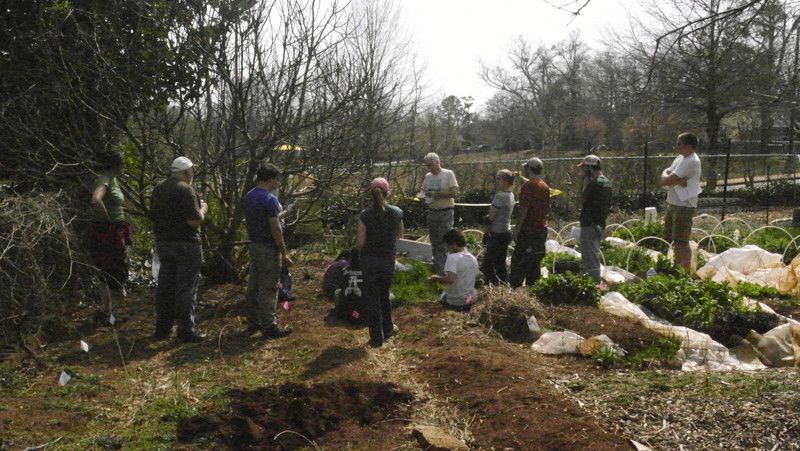 |
| Photo Caption: The beekeeping workshop at the March 2014 SCUPSablitz. |
Subscribe to:
Posts (Atom)

